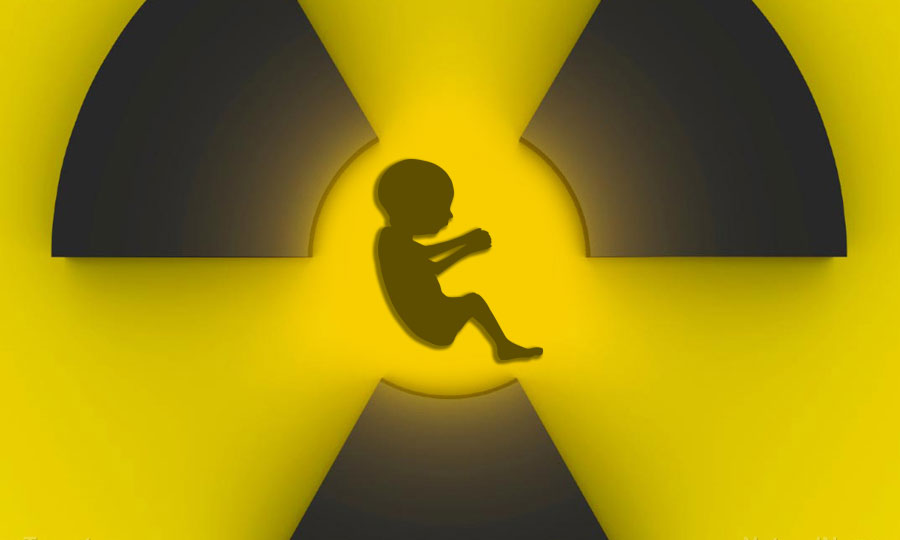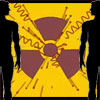Effects Of Radiation On Human Heredity
 by Jack Schubert, Ph.D. and Ralph E. Lapp, Ph.D.
by Jack Schubert, Ph.D. and Ralph E. Lapp, Ph.D.
Of the next 100 million children born to the present population in the United States, 2 million will be burdened, either at birth or before adulthood, with obvious hereditary defects, including mental deficiency, congenital malformations, deafness, blindness, and many others. If the chances of producing these hereditary defects were permanently doubled, we would eventually have 2 million additional cases of mental and physical defects, of which 200,000 would probably appear in the first generation alone.
Each dose of radiation, no matter how small, to which the reproductive cells of a future parent are exposed increases the chances of passing on additional hereditary defects to the descendants. How much radiation will perceptibly increase the hereditary defects? How much would double them? Are the amounts of radiation being received from the testing of nuclear weapons, and from medical examinations now, and amounts expected in the near future, large enough to worry about? These are questions to which we attempt to give answers to here.
Some of the information and conclusions presented are drawn from (1) the report of the distinguished Committee on Genetic Effects of Atomic Radiation of the National Academy of Sciences, and (2) the careful report on “The Genetic Effects of Radiation” in the 1956 British Medical Research Council’s report.
Each generation constitutes one link in a chain which extends back generation after generation to the dawn of human life, and will extend forward to its eclipse. Our inherited characteristics are carried from one generation to the other within the chromosome-containing nuclei of the sexual cells.
The female ovum and the male sperm cell of human beings contain 24 different chromosomes each; they combine to make the fertilized egg, which contains 24 pairs, or 48 chromosomes with their heritages from the mother and from the father—which in turn include heritages from their ancestors. Each chromosome carries within itself something like a thousand different genes, the basic units of heredity. Each gene has its own unique location in the chromosome and is arranged with the others in orderly single file along the whole length of the chromosome. If the members of a pair of chromosomes were stretched out and put alongside each other, each gene of one chromosome would be opposite a corresponding gene in the other. Thus the genes exist in pairs, just as do the chromosomes. The two members of each pair of genes are not necessarily identical but they are always similar in that they both affect, directly or indirectly, the same characteristic or function, such as hair color, stature, or a subtle mental trait.
When a cell prepares to divide, each chromosome first makes an exact copy of itself from the raw material in the cell. Consequently, when a new cell is formed, it receives 2 sets of 24 chromosomes exactly like those of the parent cell. This process of self-duplication means that the newly formed cells of the skin, liver, blood, and all our tissues, with the exception of the sex cells, contain exactly the same 48 chromosomes. However, cell divisions which just precede the formation of the sex cell follow a somewhat different pattern of chromosome formation and allotment, so that the sex cell receives only one set of chromosomes; thus the egg or sperm contains a total of 24 chromosomes and does not receive its additional 24 chromosomes until they are furnished by the other parent at the time of fertilization. This process of reduction division, called meiosis—from the Greek, meaning “to make smaller”–maintains the number of chromosomes in the fertilized egg without variation.
It often happens that one gene of a pair has a more powerful effect than the other and is spoken of as dominant, while the other type is called recessive. Red hair, for instance, is a recessive characteristic, and black hair is dominant characteristic. If the genes which determine hair color inherited from the mother and father are both the dominant black type, then the person has black hair, while if both genes are the recessive red type, the person has red hair. When the person has inherited one dominant gene for black hair color and one recessive gene for red hair color, then the hair will probably be black. However, the recessive gene may exert a slight effect, so that the hair may be slightly rusty or tawny in color.
An individual bearing two identical genes (both recessive or both dominant) for a given trait or characteristic is said to be homozygous for that particular characteristic, while one who has one gene member dominant and the other recessive is said to be heterozygous. A homozygous person must obviously have received the same type of the gene which determines this trait from each of his parents, and he will pass it on to all his children. A heterozygous person must have received a different form of the gene from each parent. On the average he will pass on one of the two gene forms to half his children and the other gene form to the other half. This sorting out of the genes is the direct result of the reduction of the chromosome number by half during the formation of the sex cells.
Here we must anticipate one aspect of our later discussion of radiation effects on heredity because it is important to recognize the significance of recessive harmful genes. Radiation, as well as many other agents, can effect sudden, permanent, and inheritable changes in genes—a process called mutation. The great majority of all mutations are both harmful and recessive. Therefore, in order to assess the potential genetic hazards of radiation, we must center much of our discussion on the harmful and recessive genes.
The degree of dominance of one gene over the other may superficially appear to be complete, but in many cases it can be shown that the recessive gene does exert some degree of influence. Thus, in the more common heterozygous state, a recessive harmful gene may still have a detrimental effect, with a resulting shortening of life, general debility, or reduction of fertility in those people who carry the hidden gene. For example, a form of anemia called Thalassaemia is found mainly in Syrian, Greek, and Italian families. The homozygous individuals invariably die from this disease, while in the heterozygous persons it is only a mild disease which may escape notice. We can easily see how subtle heterozygous damage can affect far more people than can the gross and abrupt harm suffered by those who are homozygous for the deleterious form of the gene.
Not all genes cause clear-cut effects. Rather, some gene-controlled characteristics, such as stature and intelligence, vary by continuous gradations over a wide range. These types of variation are known to be controlled by the combined cooperative actions of a large number of genes, whereas the effect of the individual gene would be too small to be distinguished if it acted by itself.
Whether a person is blue- or brown-eyed depends only on his genes, but in most cases the actions of the genes are greatly influenced by environment. For example, if a child with genes which normally would produce tall stature is badly undernourished, he may be shorter at maturity than a child whose genes would produce a shorter stature, but who was well nourished. Nonetheless, the maximum height either child can attain is still limited by the genes. Consider susceptibility to disease such as tuberculosis, to which some persons are more susceptible than average because of characteristics of their genes. However, if the TB susceptibles guard against infection and take care of their general health they may never develop the disease.
A dominant gene which is transmitted in a family will become manifest in every generation unless it dies out. On the other hand, a recessive gene can be transmitted to later generations by a person who shows no obvious sign or effect from carrying it. From time to time, when both parents happen to carry the same recessive gene, it becomes manifest in their children. Since certain traits are more common in certain families than in the population at large, the recessive trait is especially likely to become manifested in a marriage between close relatives. This fact is recognized by some governments, which prohibit marriages between first cousins, for example.
As cells divide, the genes remain unchanged, but occasionally perhaps one gene in a hundred thousand sex cells undergoes a mutation spontaneously. The result is duplicated in subsequent cell divisions. Once a gene mutates it never recovers its original form unless a further restorative mutation occurs—a very rare event indeed. When a mutation occurs in a body cell other than a sex cell, then it is merely passed along to other body cells and not to one’s descendants. It is thought by many that leukemia and other cancerous conditions may be caused by a mutation of one or more body cells, which subsequently acquire or become more receptive to uncontrolled invasion growth. Harmful as these somatic mutations are, their effect is limited to the person in whom the mutation occurs. What we are concerned with here are those mutations which arise in the sex cells and are therefore hereditary.
What causes a gene to mutate spontaneously? There are many causes—among them, these: (1) in the process of duplicating during cell division the gene may make a faulty copy of itself; (2) chemical changes may result from the random motions of the molecules in the complex structure of the gene; and (3) the actions of body chemicals and the natural background radiation may bring about mutation. Also any one or more of many external agents, especially certain chemicals which attack the cell nucleus, may be involved. Of all the external agents which can cause mutations and to which man is constantly exposed, radiation seems to be the most important and effective.
The startling fact that radiation produces mutations was first announced in 1927 at the Fifth International Congress of Genetics in Berlin by Professor H.J. Muller. Since this time Professor Muller and other geneticists have extended radiation studies on heredity to many different organisms—from bacteria to mice. These beautiful investigations form one of the most exciting and fascinating chapters of science and have attracted scientist from all fields, including physicists and chemists.
Radiation can affect the reproductive cells in three ways: (1) it can kill the cells outright; (2) it can break or damage the chromosomes; and (3) it can cause the gene to mutate. We are not concerned with the first possibility here because the death of the cell or those directly derived from it automatically eliminates it from participation in fertilization and thus in heredity.
The second possibility—chromosome breakage—is of relatively little genetic concern because it produces changes which cannot be generally transmitted to future generations. When a chromosome is broken the fragments may fail to reunite, and when the cell tries to divide, it dies in the attempt. Even if the cell manages a few divisions, the chromosome fragments become lost, so that it lacks the genes necessary for survival. If the chromosome fragments join again, the “patched-up” chromosome has difficulty finding a normal partner and the end result is a drastic reduction in fertility. Consequently, any fertilization which may take place results in an embryo which dies early in its fetal life.
What happens if the chromosome fragments reunite in such a way that the fertilized cell develops into an apparently normal individual? That person’s descendants are likely to show greatly reduced fertility manifested in repeated abortions and malformations. Experiments on mammals indicate that this inherited effect appears only if conception takes place within a few months after a heavy irradiation. After that time the sex cells which have damaged chromosomes are dead. This does not mean that the frequency of mutations transmitted to offspring declines at some time in the future, long after irradiation of the sex cells has ceased. For example, the cells which eventually produce sperm are permanently present in the male, except for those killed outright by radiation. Hence the mutations the primary sperm-producing cells carry are passed on to newly formed spermatogonia and in turn to the spermatozoa. Dr. W. L. Russell reported:
It may be concluded that these data [radiation studies on mice] indicate that, in man, offspring conceived long after exposure of the father to radiation are just as likely to inherit induced mutations as those conceived a few weeks after exposure. Putting this in practical terms, . . . although postponement of procreation for a few weeks following exposure to radiation would reduce the total risk of transmission of mutational changes, by excluding those induced in post-spermatogonial stages, further postponement would not give any additional reduction risk.
Of course, the situation in a woman whose ovaries are irradiated is quite similar to that of a man because she possesses from birth her total lifetime supply of ova.
As a matter of fact, fragmentations and dislocations of chromosomes take place usually after a large single dose of radiation and only rarely after long-continued exposures to small amounts of radiation. Therefore, from the genetic point of view we are most concerned with the effects on heredity of small but accumulating doses of radiation which induce increased numbers of the type of gene mutations which are passed on for many generations.
Mutations induced by artificial means such as x-rays are of all kinds, but these kinds are identical with the types of mutation arising spontaneously. In genetic experiments it has been found that even when the numbers of mutations are greatly increased by exposure to radiation, the new mutations studied arise in the same frequencies relative to one another. This is a very important point when evaluating the potential hazards of radiation to human beings. It means that we are not dealing with a mysterious injury of an entirely new type. It also means that we can estimate the increased occurrence caused by a given dose of radiation of a disease such as schizophrenia, for which an individual has a genetical predisposition if he is a homozygous for a specific recessive gene. It is not surprising that radiation produces no novel types of mutations because, after all, man’s sex cells have been exposed to small but measurable amounts of radiation from natural sources since he first appeared on our planet. Thus, large doses of radiation produce more mutations in man but not better or worse ones.
Another factor to be considered when estimating the effects of radiation on heredity is the age of the individual. For effects on the individual person we must consider the radiation doses received throughout life, but with genetic effects we are concerned only with the average length of time the reproductive cells are exposed to radiation. If the person is past the reproductive age, then no hereditary effects need be considered because any mutations induced are not passed on to future generations. In considering younger people we must take into account the number of offspring they may have. In the United States the average median childbearing age is less than 30 years, so this figure is used in considering the genetic effects in radiation dosages.
Let us now summarize those points involving radiation effects on heredity on which there is complete agreement by geneticists. These points of agreement are not mere opinions but are based on solid experimental observations backed up by the same type of remarkably reliable mathematics on which the hugely successful insurance business has been developed. Summarized below are some of the basic facts cited by the 1956 National Academy of Science Report:
Practically all radiation-induced mutations which have effects large enough to be detected are harmful.
A small part of the harm would appear in the first generation of the person who received the radiation. Most of the harm, however, would remain unnoticed, for a shorter or longer time, in the genetic constitution of the successive generations of offspring. But harm would persist, and some of it would be expressed in each generation. On the average, a detrimental mutation, no matter how small its harmful effect, will in the long run tip the scales against some descendant who carries this mutation, causing his premature death or his failure to produce the normal number of offspring. In this way harmful mutations are eventually eliminated from the population.
Although many mutations do disturb normal development of the embryo, it is not correct to say that all, or even most mutations result in monstrosities or freaks. In fact the commonest mutations are those with the smallest direct effect on any one generation.
Up to now we have been speaking more or less of the qualitative effects of genetic mutations and their general manifestations. However, we must know quantitatively how much radiation is now being delivered to the gonads of our population and how many increased mutations this amount of radiation produces. This has a direct bearing on just how stringent our precautions must be in order to protect our population from excessive radiation.
Now that the problem is posed, let us get to the actual numbers. While geneticists cannot give an exact figure as yet to the radiation risk, it is possible to give a minimum and maximum figure. As time goes on, more information on the effects of radiation on human heredity will accumulate, and the estimates of potential harm can be made more exact. However, the present estimates are, at the very worst, ten times too low or ten times too high. But in this area one cannot afford to be an optimist. We must, within reason and until new information becomes available, assume the worst because an error in the other direction can lead to calamity.
How many mutations occur spontaneously? According to the best conservative estimates, such as that of Professor H. J. Muller, the present population of the United States will pass on 16 million new mutations to the next total generation of about 100 million children.
How many r would it take to double the spontaneous mutation rate which constitutes a sort of “normal” burden on society? If all the spontaneous mutations were due to natural background radiation–5 r in 30 years–then the “doubling dose” would be 5 r. This, then, would be the rock-bottom minimum value of the amount of radiation needed to double the spontaneous mutation rate. However, the actual “doubling dose” is probably higher than this figure because it is known from theory and experiment that the spontaneous mutation rate also depends on factors other than radiation. The best estimates place the contribution of natural background radiation to spontaneous mutation rates at about 5 to 20 percent of the total. On this basis the doubling dose of radiation falls in the range of 25 r to 100 r.
The figure for the doubling dose can be obtained from observations made directly on plants, flies, and mice. Up until a few years ago some people thought that genetic radiation hazards were exaggerated because in the widely studied fruit fly, Drosophila melanogaster, the doubling dose for a group of genes was found to be nearly 400 r. Then Dr. W. L. Russell of the AEC’s Oak Ridge National Laboratory made careful studies of a similar set of genes in the mouse, which, like man, is a mammal, and found that the same dose of radiation produced nearly ten times as many mutations as were found in the fly; specifically he found the doubling dose to be 50 r! The mouse has 40 chromosomes, while there are only 8 in the fly. The safest assumption to make at present is to assume that man, with 48 chromosomes, would have a mutation rate more like that of the mouse, and even somewhat higher.
The net result of experiments and calculations such as these is that the most experienced geneticists in the United States and other countries have concluded that the doubling dose lies between 30 and 80 r and most probably is 40 r. Now we are in a position to assess the present and future hazard from radiation in more precise terms.
Let us review the possibility suggested at the beginning of this report. We showed that doubling the incidence of hereditary defects would produce 200,000 additional defective children in one generation alone, and eventually increase the number of deficient individuals by 2 million. It is now estimated that 40 r of radiation delivered to each and every individual in the present population of the United States would result in such a doubling of harmful genetic mutations. A dose of only 10 r accumulated by the gonads of the same population would result in 50,000 new cases of tangible inherited defects in the first generation. Assuming that the 10 r dose reaching the gonads of parents before conception of offspring was continued indefinitely to subsequent generations there would ultimately be 500,000 new cases of handicapped individuals in addition to the “normal burden” of 2 million.
These estimates do not measure all the genetic damage that would result from increased doses of radiation. A more useful long term estimate is the following from the 1956 report of the Committee on Genetic Effects of Atomic Radiation:
This consists of estimating the total number of mutant genes which would be induced in the whole population of the United States and passed on to the next appearing 100 million children, were this whole population to receive a . . . dose of 10 r [to the gonads]. Having estimated this total number of transmitted mutants induced by a dose of 10 r, one can only say then, when he wishes to translate this over into harm or damage, that each one of these mutants must eventually be extinguished out of the population through tragedy.
Six members of the Genetics Committee made independent estimates of the total number of mutants which would be induced and passed on to the next 100 million children by a total dose of 10 r to the gonads. Their most probable estimates bunched rather closely around the figure 5 million! This means also that a 40 r doubling dose would produce eventually about 20 million mutations overall—ten times the number which would be obviously detectable.
There is a another even more cogent way of looking at the genetic effects of radiation. Suppose that a group of 1 million people, having the same age distribution as the population as a whole, accumulated over the years a total of 200 r to the gonads before conceiving children. This would amount to a total dose of 200 million man-roentgens. What would be the effect on, say, approximately 500,000 children, about 10,000 would suffer obvious physical and mental defects from the deleterious spontaneous mutant genes induced from natural causes alone. However, as a result of their parents’ having received 200 r to the gonads, an additional 5000 children—an increase of 50 percent—would be substantially handicapped! In this case, a relatively simple statistical counting of defects would establish with complete certainty the connection of the increased defects with the radiation exposure.
However, if the whole population of the United States received a total of 200 million man-roentgens (which amounts to about 1 r of radiation to the gonads for each person), this would mean, since radiation doses are cumulative and there is no threshold dose, that there would result 5000 new cases of definitely handicapped children among the 100 million born to the parents who had received only 1 r apiece! But these 5000 handicapped children would be “lost in the crowd,” the overall effect being too scattered to affect the population as a whole. It would be impossible for the individual sufferers to trace their troubles to the radiation. Society would be far more impressed by the more easily detectable 5000 handicapped children born to the 1 million parents who received 200 r each.
The startling point about this example is that at least 1 million persons in the United States today are receiving anywhere from about 50 r to 300 r to the gonads! Who are these people? The answer lies in the widely quoted and conservative report by Dr. Stanley H. Clark, medical physicist at Cedars of Lebanon Hospital, Los Angeles, who made a survey of the “Genetic Radiation Exposures in the Field of Medicine.” His data led to the estimate (given in the compilation by consultants to the Genetics Panel of the National Academy of Science) that a combined total 215,000 radiologists, general practitioners, and dentists receive an average dose per year of 2 r to 5 r, while some get 15 r a year to the gonads just from their routine handling of x-ray machines and fluoroscopes. Dr. Clark states that his figures are too low and that they probably should be doubled. Actually, we know from our own observations and especially from the data we have cited earlier that Dr. Clark’s figures are too low. At least an additional 100,000 osteopaths, chiropractors, x-ray technicians, dental assistants, nurses, and other attendants probably receive as much gonad radiation as—and in some cases more than—the physicians. Further, there were about 5 million fluoroscopies made in 1 year, which on the average delivered a significant dosage to the gonads of patients. Perhaps ½ million of these fluroscopies were made on children under 11 years of age, and another ½ million to people between the ages of 12 and 30. When one considers that these people are re-examined over the years and that the radiation exposures deliver many more roentgens than are reported, one can see that our estimate that at least 1 million persons in the United States received doses of 50 r to 300 r before conceiving is very conservative.
Now the full genetic effect of the large radiation doses received by the aforementioned million people is mitigated by marriage of the irradiated individuals with persons who have not received such high does of radiation. As is stated in the report of the Medical Research Council of Great Britain:
It is only if members of an irradiated group or their descendants intermarry over several generations, and do not mate with the un-irradiated population, that there is likely to be a disproportionately greater manifestation of hereditary defects among the descendants.
. . . A relatively high dose to a fraction of the population can only be offset by a correspondingly low dose to the remainder. If, therefore, we are to contemplate the possibility—and the necessity to develop the beneficent uses of atomic energy and ionizing radiations forces us to do so—that a significant fraction of our population may in future be allowed to receive doses of radiation of a similar order to the doubling dose, then it becomes additionally important to ensure that the dose of radiation to the rest of the community shall be held to the lowest possible level.
Do the million or more people who receive 50 r or over before conceiving children marry un-irradiated people? Our opinion, which must be checked by a careful survey, is that these people tend to marry those who also receive above average doses of radiation. Our reasoning is based on the general observation that the individuals who are subjected to the greatest number of medical diagnoses and treatments using radiation are generally those in the upper economic levels, and the better-educated groups. These people tend to marry, on the average, people from their own social and economic groups. This conjecture is well worth checking. We already have evidence that in a selected group of persons—the radiologists—their children do indeed tend to show a slight but significantly higher proportion of congenital and other defects than do the offspring of those physicians who do not receive so much radiation exposure. In view of the opinion we have expressed here, it would have been even more illuminating if the accumulated radiation doses of the wives were also known. In any event we would estimate that, conservatively, the radiologists in the survey received on the average a minimum of 50 r and as much as 200 r to their gonads before becoming parents—their wives undoubtedly less.
Excerpt from Radiation: What It Is And How It Affects You
Part II coming soon.
Posted in Health, Other Topicswith comments disabled.





